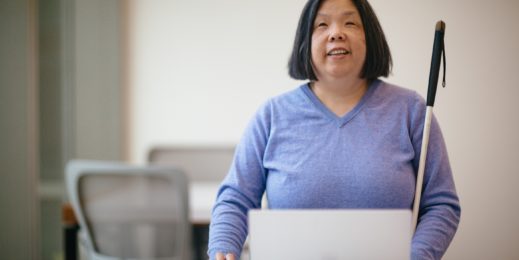
The Smith Family delves into data to maximise impact and bridge digital divide
One in every six children and young people in Australia live in poverty. Tens of thousands of them are receiving support from The Smith Family to make the most of their education.
As Australia’s leading children’s education charity, The Smith Family understands the value of data in ensuring that every dollar donated, and every hour volunteered, achieves maximum impact for the 57,000 young people it supports through its Learning for Life program.
Chief executive officer Dr Lisa O’Brien explains that The Smith Family; “Wants to significantly increase the number of students that we support on our evidence-based programs and to help them to break that cycle of disadvantage.” Over coming years she says that digital and data will help amplify and accelerate The Smith Family’s mission.
Armed with longitudinal data about the young people on its Learning for Life program, The Smith Family is building an evidence base to reveal what strategies work best and to quantify the impact of its learning and mentoring programs. That’s critical in terms of building lasting relationships with supporters and with Government, says Dr O’Brien.

The Smith Family is already using Office 365 and Power BI, with plans to also rollout Microsoft Dynamics 365 widely, to create a data-rich environment and connected modern workplace geared for precisely that. It has also adopted Microsoft’s Common Data Model for Not-for-Profits which will help The Smith Family continue to innovate without needing to invest heavily in bringing data from multiple systems and applications together.
As The Smith Family adds additional Dynamics 365 functions or builds its analytics capabilities, the common data model provides a solid data structure and foundation. It also helps democratise access to data across the organisation so that people have the best, and most accurate information, to help them succeed.
According to Dr O’Brien; “It’s about creating a great environment and giving people the tools that enable them to work as effectively as possible.
Digitisation and innovation is very much in the heart of The Smith Family’s strategy to ensure that the students we support have the skills and the capabilities that they need in such a rapidly changing world. Disadvantaged young people, like all young people, need to be able to constantly adapt in this changing environment. So we want to make sure that the young people we support have these skills.
It’s a particular challenge for the 57,000 young people on the Learning for Life program – a quarter of whom did not have a computer at home or access to reliable internet at the start of the COVID pandemic last March. That digital divide was compounded during pandemic-related lockdowns, when many students did not have the technology they needed to allow them to participate fully in their school or university remote learning initiatives.
“We know that that lack of digital skills and access is much more common in the socio-economically disadvantaged,” says Dr O’Brien. “Apart from all the other challenges that they face with their educational attainment, they often don’t have the tools and capabilities that they need to achieve at school. Also when these young people transition into employment or university, many don’t have the essential skills needed to succeed in today’s world.”
As the effects of the COVID pandemic became apparent, The Smith Family swung into action to try to bridge that digital gap – but even now one in five of the students it supports still lacks a computer or home internet. There is much more to be done.

Connection and impact
A national organisation, The Smith Family has 750 staff working across every State and Territory, and it partners with more than 740 schools – in some of the country’s most disadvantaged areas. Teams and Yammer allow staff and volunteers to stay connected with colleagues across the country, maintaining that connection even through COVID related restrictions.
Dr O’Brien notes; “As a not-for-profit, resources are always constrained. Having the tools to allow us to work really efficiently and effectively, while still delivering best practice programs is really important to us.”
The transformation initiative underway at The Smith Family is geared to ensuring the organisation has access to accurate and current data to steer strategy and decision making. It’s also constructing a modern, connected and increasingly automated workplace – freeing team members and volunteers from ‘administrivia’ and providing anywhere, anytime access to systems, giving them more time to work directly with students.
Wendy Field, Head of Policy and Programs, says the organisation is moving away from its heavy paper-based and manual processes to a data enriched and more digital operation, offering consistency and clarity to employees and volunteers, thanks to Dynamics 365.
Chief information officer Mathews George stresses that technology is the catalyst that accelerates the impact The Smith Family already has. The evidence-based and digital first approach being championed by The Smith Family is summarised by a ‘try, test and learn’ approach, he says.
“Through this implementation of Dynamics 365 and the innovation that it brings, we are able to do more of that try, test and learn,” says George. Dynamics 365 is the digital glue binding students and their families, supporters, and volunteers, with specially designed experiences for each group of stakeholders.
He explains that Dynamics 365 has been configured for The Smith Family’s particular needs. “This is a very long running process. You know, many of our students join the Learning for Life program at a primary school and continue on to tertiary education. And the volunteer that may be supporting an aspect of that program, such as volunteering at one of our after-school Learning Clubs, may also be there for a much longer time.
We are using Dynamics 365 along with the not-for-profit accelerator. It’s been great that we are able to leverage the research investment that Microsoft has done in the not-for-profit space to accelerate our journey. And then we are adapting it from there.
Wendy Field says that accurate and complete data is particularly important in matching students with potential volunteers or sponsors, in order to ensure impact and relationship longevity. “Drilling into the data and looking across the database at what works for whom and making those matches more sticky, I think, is a real potential of Dynamics 365 that we’re really looking forward to exploring and we don’t have with our current systems,“ she says.

The Smith Family has already built a data warehouse that it moved to Microsoft Azure last year to ensure it has the infrastructure to be able to scale up and down at will, and is providing Power BI to allow employees to surface any data that they need, when and where they need it.
George notes that; “People join The Smith Family to make a difference in the lives of the students that we support. So what the technology strategy does, is free up our people to do that. The aim of the technology strategy is to minimise the cost and the complexity of our IT operating environment, so that The Smith Family can achieve scale for its evidence-based programs, more sustainably,” while also fostering agility and encouraging ongoing innovation.
George says that the selection of the Microsoft digital ecosystem was made deliberately with that goal in mind. “It’s in our strategy – Microsoft first. With one preferred partner we can reduce the complexity of our IT operating environment, so that we can put more of our money back into improving our students’ educational journeys.”
Everything that we do starts with that purpose and ends with that purpose.









